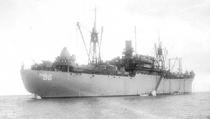(published in the Kings Pointer, Spring 1991)
The few commuters in Manhattan that Saturday morning quickly disbursed upon emerging from the subway leaving behind two rubberneckers. They approached each other and simultaneously asked, “Which way to the Christopher Street Post Office?”
That is how I first met fellow Brooklynite Harold (Hal) R. Tall on December 6, 1941. Both of us were about to take the examination for admission to the U.S. Maritime Commission Cadet Corps. High school graduation for me was seven weeks in the future. Hal, a year older, had already graduated. Both of us were enamored with the sea and were very excited at the prospect of soon shipping out. News the next day of the attack on Pearl Harbor enhanced our determination.
Despite our both being quickly admitted to the Cadet Corps in January 1942, I did not meet Hal Tall again until mid 1946 when, as Navy officers, we both reported to USS MATHEWS (AKA-96), he as the first lieutenant and me as the chief engineer. Since he opted for a career on deck and I for one below, we had, in 1942, spun in separate orbits during the five hectic weeks before being assigned as cadets in separate merchant ships. The five-week indoctrination, if it can be called an indoctrination, included our helping to move the Corp’s gear from Fort Schuyler to the former Chrysler Estate and scrounging for furniture then being removed from passenger liners during their conversion to troopships. We were assisting in the creation of the U.S. Merchant Marine Academy. Our different seagoing objectives also accounted for our not meeting after our December 1942 return to the Academy. We graduated and reported for active duty in the Navy seven-months later.
In MATHEWS I got to know more about Hal and his fabulous seagoing heritage. When my grandparents were migrating from Italy to America (1871-1881), Hal’s grandfather was the master of a square rigger out of Blackpool, England that saw mostly China trade. While Hal was good at embellishing tales, he convinced me that the old man really made a fortune by running guns to Sun Yat Sen. Hal’s father, who started as a cabin boy in his own father’s ship, also rose to master and, during World War I, commanded a U.S. Navy ship.

Of course in MATHEWS we fulfilled our roles as the leaders of natural enemies, i.e., the deck apes topside vs. the soot-encrusted apes below. Episodes bordered on those described by Guy Gilpatric in his legendary Colin Glencannon stories. But each of us did not tolerate criticism of the other from anyone who was not a Kings Pointer from Brooklyn. There are fabulous stories to tell about times ashore in great ports. But the best involved Hal’s bride of about two weeks, the late Mary Jane O’Donnell Tall.
MATHEWS was secured alongside a repair ship that was moored in San Diego Bay. Floating scaffolding was rigged between the two ships and MATHEWS’ starboard side had just been completely painted. Tugs were scheduled to arrive the next morning to turn the ship around so that the extensively rust-streaked port side could be painted. Hall Tall, being the command duty officer, had to remain on board and thus I went ashore for the purpose of escorting Mary Jane for her first visit in MATHEWS and for Sunday dinner. She also had a marine heritage.
Mary Jane’s widower father, who had operated the largest coppersmith works in San Francisco, often took his young daughter with him on Sunday visits to merchant ships for the purpose of estimating repairs. Chief engineers would usually offer invitations for dinner on board. Thus, Hal Tall was blessed with a wife who indeed knew what the word shipshape meant.
Near the wharf we met the Commanding Officer who was then returning from a few days leave to MATHEWS, his first command. I introduced Mrs. Tall and he promptly invited us to ride in his gig. He was pleasant and animated, and could not have been more gracious. As MATHEWS loomed over us, the obviously proud skipper asked, “Well, Mrs. Tall, what do you think of my ship?”
Without batting an eye Mary Jane replied, “Quite frankly Captain, it needs a paint job!”
The skipper’s smile vanished as mine was breaking out. Mary Jane knew that her husband was the first lieutenant, but she obviously didn’t know that, in Navy ships, the first lieutenant was responsible for keeping the ship painted.
As is Navy custom, the skipper preceded us up the accommodation ladder. Hal was shocked by the sudden outburst, “I told you to get the ship painted as soon as possible. Even your own wife says it needs a paint job!”
With that the Captain stormed off as Hal tried unsuccessfully to explain that the other side was completely painted, that the ship would be turned around tomorrow, etc. But he hadn’t entirely lost his sense of humor. He turned to Mary Jane and said dramatically, “Big mouth!”
Some Kings Pointers of the late forties will remember Hal Tall as a naval science instructor. I doubt if they knew that he had received a medal for a rescue at sea during the 1945 typhoon near Okinawa. Years later when in command of a destroyer, he boldly moved his ship into uncharted reefs off of the Philippines and rescued the crew of a fishing vessel.
Hal’s post-Navy career was devoted to serving the City of Baltimore as Deputy Director of Finance during the years when Baltimore led in the development of city-management methods. He was apolitical in a poltical environment, was respected by all, and finished his service as the Director of Finance.
Among the mourners accompanying Hal’s daughter, Kathye, during his March 1990 funeral, were the Governor of Maryland and the Mayor of the City of Baltimore.
***************
Copyright © 2005 (text only) by Louis D. Chirillo
